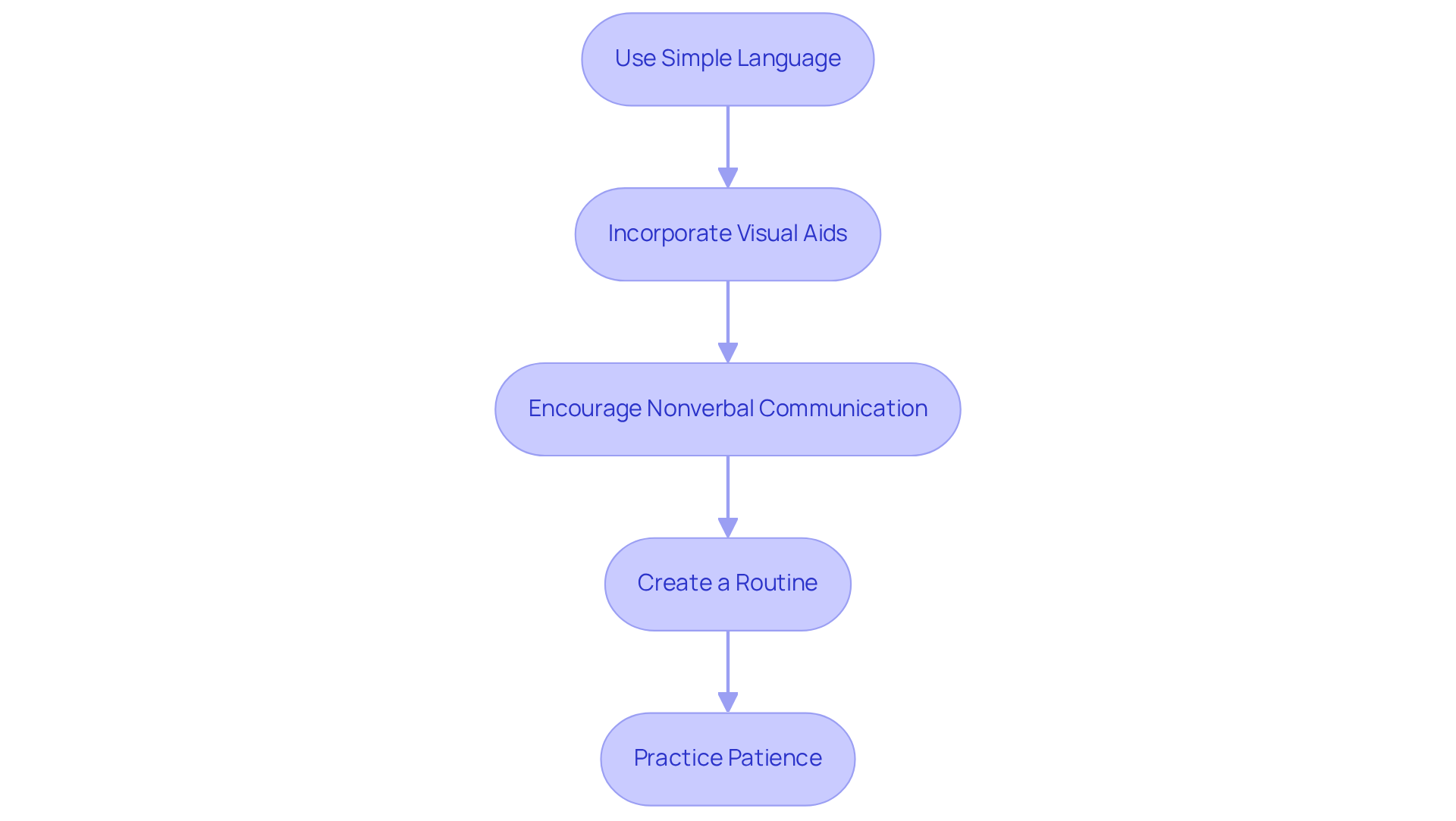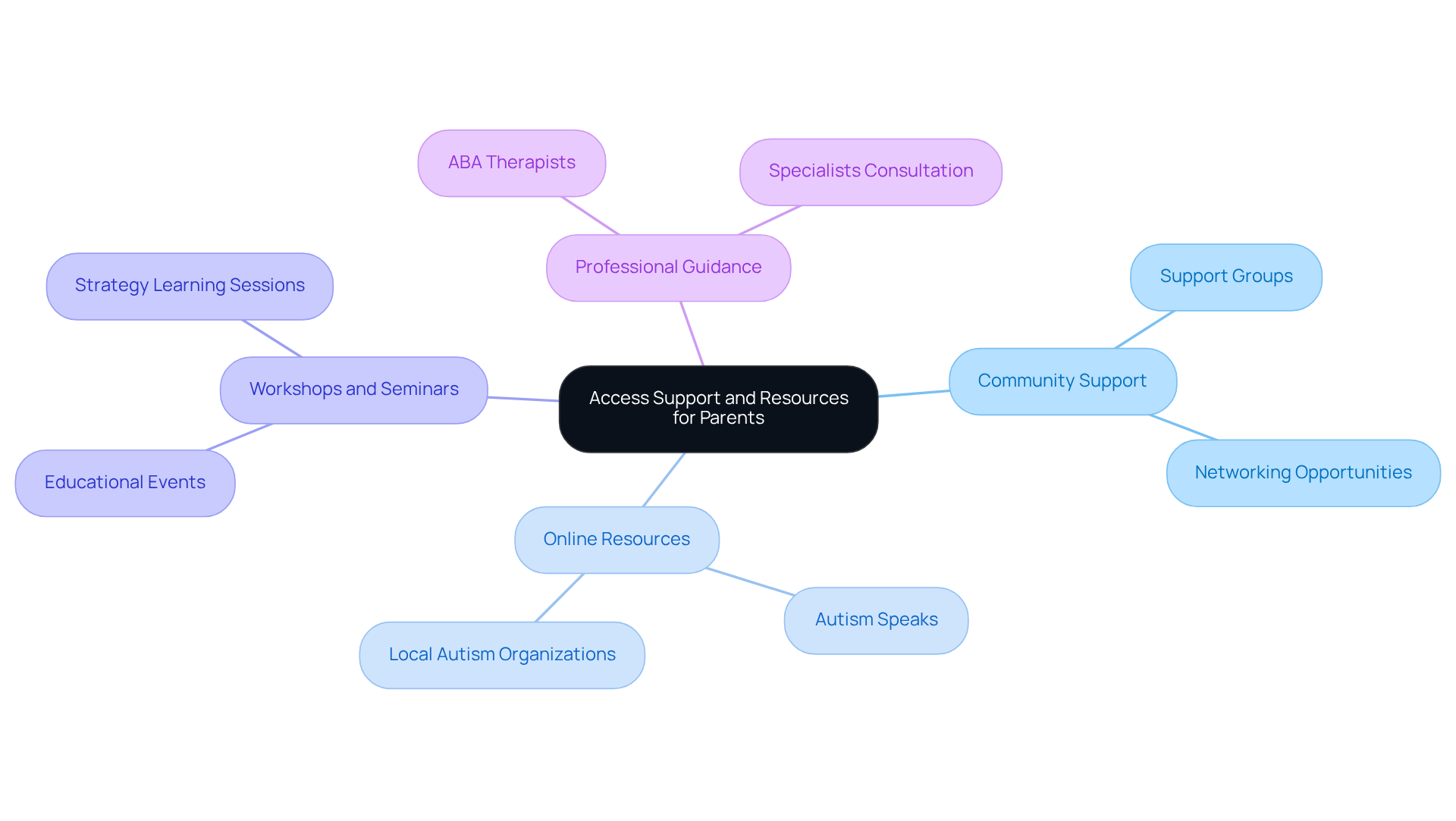Overview
Communicating effectively with a nonverbal autistic child can be a challenging yet rewarding journey for parents. Utilizing alternative communication methods such as PECS, sign language, and AAC devices can make a significant difference. Daily practices like using simple language and incorporating visual aids not only enhance understanding but also create a nurturing environment that responds to the child's nonverbal cues.
These approaches are more than just strategies; they are pathways to deeper connections. By acknowledging and responding to a child’s unique ways of expressing themselves, parents can foster an atmosphere of support and encouragement. Imagine the joy of seeing your child express their needs and emotions more clearly—this is the ultimate goal.
As you explore these methods, remember that every small step taken is a step toward improving communication outcomes. Embrace these strategies, and consider sharing your experiences or seeking advice from others who understand this journey. Together, we can create a supportive community that uplifts and empowers our children.
Introduction
Understanding the complexities of nonverbal autism is essential for fostering effective communication with children who face unique challenges in expressing themselves. Many parents navigate a world where traditional verbal interactions fall short, often leaving their children feeling isolated and misunderstood. This article delves into practical strategies and alternative communication methods that can empower nonverbal autistic children to connect with their families and peers.
How can parents bridge the gap between silence and understanding, transforming challenges into opportunities for meaningful interaction? Together, let’s explore ways to nurture these connections.
Understand Nonverbal Autism: Key Characteristics and Challenges
The challenges of non verbal autistic children in verbal communication significantly impact many young individuals who may not develop spoken expression or exhibit limited speech abilities. Understanding these challenges is crucial for parents. Key characteristics include:
- Limited or Absent Verbal Communication: It’s estimated that around 25 to 30 percent of children with autism spectrum disorder (ASD) are minimally verbal or do not speak at all. Often, they rely on a few words or phrases. Unfortunately, the likelihood of gaining functional communication skills after age five is quite low, underscoring the importance of early intervention.
- Use of Nonverbal Cues: Many of these children depend on gestures, facial expressions, and body language to express their needs and emotions. This reliance highlights the necessity of understanding and interpreting these nonverbal signals.
- Social Interaction Difficulties: Non verbal autistic children frequently encounter obstacles in engaging in typical social exchanges. This can impede their ability to forge connections with peers and participate in group activities, which are vital for their social development.
- Sensory Sensitivities: Numerous children experience heightened sensitivity to sensory stimuli such as sounds, lights, and textures. This sensitivity can influence their behavior and efforts at expression.
Recognizing these traits is essential for parents as it allows them to tailor their interaction strategies effectively. For instance, using visual aids and alternative methods of communication, like boards or apps, can significantly improve interactions. Experts emphasize that fostering joint attention—where a child shares focus on an object or event with another person—is essential for developing communication skills. Research suggests that joint attention skills are strong predictors of long-term progress in expressive language for individuals with autism. By addressing these challenges with informed strategies, parents can pave the way for improved outcomes for their non verbal autistic child.
Explore Alternative Communication Methods: Tools and Techniques
Alternative means of interaction can significantly enhance the capacity of a non verbal autistic child to convey their thoughts. Consider these effective tools and techniques that can make a difference:
- Picture Exchange Communication System (PECS): This widely used method employs pictures to facilitate communication. Research indicates that individuals using PECS are 3.90 times more likely to be in a higher PECS-use category compared to those not using it (OR 3.90, 95% CI 1.75 to 8.68, P < 0.001), demonstrating its effectiveness in promoting communicative initiations. Parents can create a communication board showcasing images that represent different items or actions, enabling youngsters to express their needs more effectively.
- Sign Communication: Teaching fundamental sign communication can empower youngsters to express themselves without relying solely on verbal words. Success stories highlight that many nonverbal individuals have made substantial advancements in communicating their needs through sign language, fostering a sense of independence and confidence. For instance, a case study revealed that a young individual who learned basic signs was able to express their needs more clearly, reducing frustration and improving interactions with peers.
- Augmentative and Alternative Communication (AAC) Devices: These electronic tools allow young individuals to produce speech through touch or eye movement. Recent advancements in AAC technology have made these devices more accessible and user-friendly, enhancing interactions for nonverbal youth. Experts emphasize that AAC can serve as a vital resource in fostering language development, enabling young learners to communicate effectively while they are acquiring speech.
- Visual Schedules: Utilizing visual schedules can assist young individuals in understanding daily routines and transitions, which subsequently alleviates anxiety and enhances overall communication. Studies indicate that young individuals using visual schedules experience reduced anxiety and are better equipped to manage their daily activities. By offering a clear visual depiction of what to anticipate, young ones can feel more secure and engaged in their surroundings.
By exploring these alternative communication methods, parents can identify the most suitable approach for their child's unique communication style, ultimately enhancing their ability to connect and express themselves.
Implement Daily Communication Strategies: Step-by-Step Approaches
When it comes to effectively communicating with a nonverbal autistic child, consider these daily strategies that can make a significant difference:
- Use Simple Language: Speak in short, clear sentences to avoid overwhelming your little one. This approach helps them grasp concepts without confusion, making communication feel more manageable.
- Incorporate Visual Aids: Utilize pictures, symbols, or visual schedules to represent words and concepts. Research shows that visual aids can greatly enhance comprehension and communication for a nonverbal autistic child. Since around 30% of individuals diagnosed with autism are nonverbal autistic children who remain minimally verbal past age 5, these strategies are truly essential.
- Encourage Nonverbal Communication: Pay close attention to your child's gestures, facial expressions, and body language. Responding to these nonverbal cues from a nonverbal autistic child not only validates their attempts to communicate but also fosters a supportive environment where they feel understood.
- Create a Routine: Establishing consistent daily routines can help your child anticipate activities, reducing anxiety. Predictability enhances their ability to engage in dialogue, making interactions smoother and more enjoyable.
- Practice Patience: Allow your child ample time to process information and respond. This patience is crucial in creating a nurturing interaction environment where they feel comfortable expressing themselves.
Involving family in these strategies can lead to even better outcomes. Active participation enhances consistency and helps generalize the skills learned in therapy. By implementing these approaches, you can significantly improve the ability of your nonverbal autistic child to communicate effectively, paving the way for better interactions and understanding. Remember, timely intervention is key, as it can lead to more effective communication outcomes for individuals with autism.

Access Support and Resources: Building a Community for Parents
Building a community and accessing resources can profoundly benefit parents of nonverbal autistic children. Connecting with others who face similar challenges can be incredibly comforting. Joining support groups offers emotional support and practical advice, creating a network of understanding.
Additionally, utilizing online resources can be a game-changer. Websites like Autism Speaks and local autism organizations provide valuable information and tools that can empower parents in their journey.
Attending workshops and seminars also presents an opportunity for growth. These educational events allow parents to learn new strategies and connect with professionals who can offer insights into their child's unique needs.
Lastly, seeking professional guidance is crucial. Consulting with ABA therapists or specialists can provide tailored strategies and support, ensuring that each child's specific needs are met.
By accessing these resources, parents can feel empowered and supported, knowing they are not alone on this journey.

Conclusion
Effectively communicating with a nonverbal autistic child involves a compassionate approach that honors their unique communication style and needs. By understanding the challenges they encounter and applying tailored strategies, parents can greatly improve their child's ability to express themselves and connect with the world around them.
This guide emphasizes the significance of:
- Recognizing nonverbal cues
- Utilizing alternative communication methods such as PECS and AAC devices
- Integrating daily strategies that promote meaningful interactions
Building a supportive community and accessing valuable resources can empower parents to navigate this journey with both confidence and compassion.
Ultimately, the experience of communicating with a nonverbal autistic child transcends mere methods; it is about creating an environment filled with understanding, patience, and love. By embracing these strategies and seeking support, parents can help their children flourish, paving the way for enriching experiences and meaningful connections in their lives.
Frequently Asked Questions
What are the key characteristics of nonverbal autism?
Key characteristics include limited or absent verbal communication, reliance on nonverbal cues (gestures, facial expressions, body language), difficulties in social interactions, and sensory sensitivities to stimuli like sounds, lights, and textures.
What percentage of children with autism spectrum disorder are minimally verbal or nonverbal?
It is estimated that around 25 to 30 percent of children with autism spectrum disorder (ASD) are minimally verbal or do not speak at all.
Why is early intervention important for nonverbal autistic children?
Early intervention is crucial because the likelihood of gaining functional communication skills after age five is quite low.
How do nonverbal autistic children express their needs and emotions?
Many nonverbal autistic children express their needs and emotions through gestures, facial expressions, and body language.
What challenges do nonverbal autistic children face in social interactions?
They frequently encounter obstacles in engaging in typical social exchanges, which can impede their ability to connect with peers and participate in group activities.
What role do sensory sensitivities play in nonverbal autism?
Sensory sensitivities can influence behavior and efforts at expression, as many children may have heightened sensitivity to sounds, lights, and textures.
How can parents improve communication with their nonverbal autistic child?
Parents can improve communication by using visual aids and alternative methods of communication, such as boards or apps, and by fostering joint attention.
What is joint attention and why is it important?
Joint attention is when a child shares focus on an object or event with another person. It is essential for developing communication skills and is a strong predictor of long-term progress in expressive language for individuals with autism.




